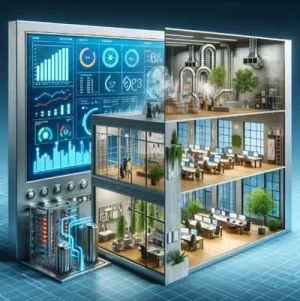The Internet of Things Revolution: Integrating Smart Devices with BAS

Building Automation Systems (BAS) have transformed building management, offering centralized control and automation of various building functions like HVAC, lighting, and security. However, the emergence of the Internet of Things (IoT) presents exciting new opportunities for BAS. By integrating with a vast array of smart sensors and actuators, BAS can evolve into a powerful tool for real-time data collection, automated control strategies, and ultimately, a new level of building intelligence.
This article explores the integration of IoT devices with BAS, examining the benefits, potential challenges, and technical considerations for creating a truly connected building environment.
Visit Our Building Automation Study Course
Unlocking Potential: Benefits of IoT Integration with BAS
The integration of IoT devices with BAS offers several compelling benefits:
Enhanced Data Collection: A multitude of IoT sensors can be deployed throughout a building, collecting real-time data on environmental conditions like temperature, humidity, occupancy levels, and even air quality. This granular data provides a more comprehensive understanding of building performance and occupant behavior.
Automated Control and Optimization: Based on the real-time data collected from IoT devices, BAS can automate various building functions. For example, occupancy sensors can trigger lighting adjustments in unoccupied spaces, leading to energy savings. Temperature sensors can be used to optimize HVAC operation, ensuring occupant comfort and reducing energy consumption.
Predictive Maintenance: By analyzing sensor data over time, BAS can identify potential equipment failures or inefficiencies before they occur. This allows for preventive maintenance, reducing downtime, extending equipment life, and minimizing repair costs.
Improved Occupant Comfort and Experience: IoT-enabled BAS can personalize occupant comfort by adjusting lighting and temperature based on individual preferences or occupancy patterns. This can lead to a more comfortable and productive work environment for building occupants.
Enhanced Building Security: IoT devices like smart locks and security cameras can be integrated with BAS, providing real-time monitoring and access control capabilities. This can improve building security and contribute to a safer environment for occupants.
Challenges and Considerations: Navigating the IoT Landscape
While IoT integration offers significant advantages, some challenges need to be addressed:
Data Overload: The sheer volume of data generated by numerous IoT devices can overwhelm BAS systems and require robust data management solutions to ensure efficient processing and analysis.
Device Interoperability: A vast array of IoT devices from various manufacturers exist, and ensuring compatibility with different communication protocols can be a challenge. Standardized communication protocols are crucial for seamless integration with BAS.
Network Bandwidth Requirements: The constant transmission of data from numerous IoT devices can strain network bandwidth. Building owners need to assess network capacity and potentially upgrade infrastructure to accommodate the increased data traffic.
Security Concerns: Securing IoT devices is critical. Building owners must ensure these devices have robust security features and are not vulnerable to hacking attempts that could compromise the entire BAS network.
Technical Considerations for Successful Integration
Successful integration of IoT devices with BAS requires careful planning and attention to technical details:
Communication Protocols: BAS should be able to communicate with diverse IoT devices using standardized protocols like BACnet, Zigbee, or Bluetooth Low Energy (BLE). This ensures seamless data exchange and avoids compatibility issues.
Data Management: A robust data management strategy is essential. Building owners need to establish a system for data collection, storage, analysis, and visualization. Cloud-based solutions can be beneficial for centralized data management and analytics capabilities.
Network Infrastructure: The network infrastructure needs to be evaluated to ensure sufficient bandwidth and reliability to handle the increased data traffic resulting from IoT device integration. This might necessitate network upgrades or network segmentation strategies.
Cybersecurity Measures: Implementing robust cybersecurity measures is crucial. This includes securing individual IoT devices through regular firmware updates and strong authentication protocols. Additionally, secure communication channels and network segmentation can minimize the risk of cyberattacks.
The Future of BAS: Embracing the Power of IoT
The integration of IoT devices with BAS represents a significant leap forward in building automation. Real-time data collection, automated control strategies, and the potential for personalized occupant experiences create a future where buildings are not only efficient but also truly intelligent and responsive to the needs of their occupants.
As technology continues to evolve, standardized communication protocols will become more prevalent, and the security of IoT devices will improve. This will pave the way for even deeper integration and the emergence of truly smart buildings that optimize not just energy consumption but also occupant comfort, security, and overall well-being.
Building Real Intelligence
While some challenges remain, the integration of IoT devices with BAS presents an exciting opportunity to transform building management. By embracing the power of IoT and adopting a collaborative approach that involves building owners, system integrators, and IT professionals, stakeholders can create a future of intelligent buildings that operate in a truly harmonious and data-driven manner. This symphony of intelligence will not only optimize energy consumption and building performance but also create a more comfortable, secure, and sustainable built environment for generations to come.








